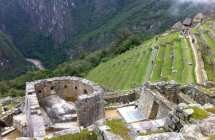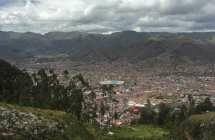I had ten days in Peru to see as much as possible. I arrived in Lima and took the next flight out to Puerto Maldonado to start the trip at the very end and make my way back west to Lima for my flight home. I decided to treat this trip as a highlights tour and come back in the future to explore it further with more time in my hands. For this reason, I had to perfectly plan the trip and book everything in advance to make sure nothing would go wrong. I took a night bus to Nazca from Arequipa to arrive at 6:30 am just in time for my 45-minute flight over the Nazca lines and then I’d leave the city two hours later to spend the afternoon wine-tasting in Ica.
But I missed the bus.
I was left with five hours to spare to explore Nazca. Since I hadn’t premeditated that I’d be in this situation, I had no idea what to do, so I started asking friendly-looking people for fun activities to do to kill some time. To my surprise, I found a myriad of interesting places to explore.
Cahuachi was a ceremonial center in Nazca where many other cultures around the area made a pilgrimage to worship gods and trade goods. Cultures from the Amazonas, the Andes, and other places headed here and this is the reason why the famous Nazca Lines depict figures that would have been impossible for the Nazca, a group that lived in the desert, to ever know about (i.e. the monkey figure and the whale). If what you are looking for is an untouched place away from the tourist hot spots, head here. I was the only person on the site during the whole time I was there.
Located 30 kilometeres (19 miles) south of Nazca City is an outdoor necropolis known as Chauchilla Cemetery. The burial grounds contain mummified Nazca people as well as archaeological artifacts that are still intact. Visiting Chauchilla will give you a great insight into the way the Nazca people lived and their survival methods in the arid desert.
Cerro Blanco is often overlooked, or never heard about, because of the high advertising done to Huacachina. Many visitors in Peru have no idea that a less visited sand dune is available for trekking and sand boarding. In fact, it is the tallest sand dune in the whole world. Due to the steepness of the dune, buggies cannot be driven to the summit and instead, you must hike up for several hours, but the trek up is just as exciting as the sand boarding itself due to the sights (in very clear days, you’ll even get to see the Pacific Ocean from here!).
Located only 4 kilometers away from the city center, the Cantalloc Aqueducts are an immaculate example of Nazca hydraulic engineering. These aqueducts have been in use for over a thousand years and have managed to survive the test of time. The Nazcas lived in the desert and hence, they had no water available for drinking and agriculture so they build these masterpieces of engineering to bring water in from the Andes mountains. There are a total of 46 aqueducts in the site, some are quite small but as you go further in, they grow in size. To date, these aqueducts still serve their purpose of providing potable water to the residents of Nazca.
-
Two daysMayor cities such as Cuzco, Arequipa and Lima have direct buses to Nazca.
From Puno, buses don't leave directly, you will need to head to Arequipa first and then take another bus.Unless you have your own car with you, taxis as the way to go in most cases unless you book a tour through an agency or hotel.
Updated: April 18, 2015











































